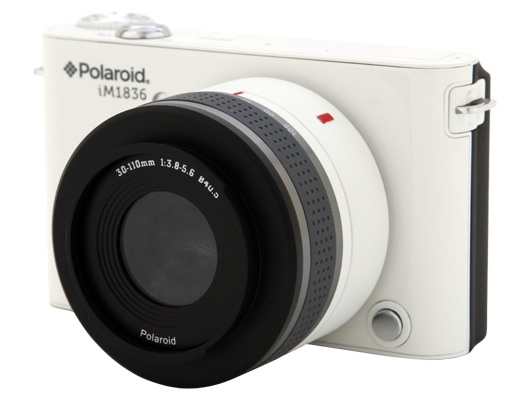Polaroid Reveals World's First ILC Android Camera
by Jason Inofuentes on January 9, 2013 3:44 AM EST- Posted in
- Trade Shows
- Android
- jelly bean
- CES 2013
- Polaroid

Polaroid has been struggling to define itself in the last … well, few decades. In the pursuit of new markets, they’re blazing a trail to become the first interchangeable lens Android camera to come to market. The 18MP camera will ship during the second quarter of 2013, and retail for $349 as a kit with a 10-30mm lens. The mirror-less shooter is unique by including its sensor within the lens, itself (not encouraging in terms of sensor size). Later in the year Polaroid plans to release a telephoto lens and a 50mm prime; and eventually they plan on providing an adapter to fit competitor’s lenses.
As for the operating system, the Jelly Bean build is modified to create three different modes, a shooting mode, an editing mode and an app mode. WiFi and Bluetooth are on hand for connectivity, but there’s no current plans for wireless broadband options. Polaroid didn’t have a huge amount of technical details for us, but we’ll try and chase down more information as soon as we can.










10 Comments
View All Comments
Nakedpeanut - Wednesday, January 9, 2013 - link
I really like this idea of snapping photos and having the ability to edit and upload them on the fly using a decent camera.RoboJ1M - Wednesday, January 9, 2013 - link
Also: Angry Birds.piroroadkill - Wednesday, January 9, 2013 - link
I saw "ILC" and wondered what it meant.I'd say this was EVIL - Electronic Viewfinder Interchangeable Lens.
Tells you more, because then you don't think it's a real SLR.
extide - Wednesday, January 9, 2013 - link
Well, duh it's not an SLR, it's mirrorless.piroroadkill - Wednesday, January 9, 2013 - link
Never mind, I was referring entirely to the use of "ILC".I know it's not SLR, but ILC tells you nothing about the type of camera other than you can change the lens.
Hence me saying you should prefer a term that encompasses the lens changing AND whether it is electronic only or not.
BugblatterIII - Wednesday, January 9, 2013 - link
I'm not an expert but I've read that the closer the lens is to the sensor the smaller the lens can be. So the additional space needed for the sensor might be more than offset by the saving on the actual lens.Drizzt321 - Wednesday, January 9, 2013 - link
Not exactly correct. The smaller the sensor is, the smaller the circle of light the lens needs to provide which generally leads towards smaller lenses with less glass which tends to mean less expensive. As a side effect, a smaller sensor tends to have larger depth of field (more of the image is in focus), however you need a lens with shorter focal lengths to get the wider fields of view. This is why you'll see in cell phones the lenses tend to be something like 2 or 3 millimeters, and because of the super tiny sensors it leads to a Field of View about the same as 24-28mm on a full frame 35mm sensor, which is fairly wide (so you can get more of your friends in the shot), and can tend to have slower shutter speeds that you won't notice hand holding.However, while the lens can be a significant cost of a camera (especially big lenses with lots of glass), the sensor, even small ones such as would go on this, does make up a decent amount of the cost of the system. However, an advantage in this system would be a consistent user interface, and a lens+sensor that can be tuned to an extreme amount for specific purposes. Want a telephoto? Have a slightly longer lens with a smaller sensor. Want something that's more easily pocketable but better quality than most camera-phones? Have a slightly larger sensor but very wide lens that also has a wide aperture to let in more light.
BugblatterIII - Thursday, January 10, 2013 - link
Interesting info thanks, but you've not explained why having the sensor closer to the lens doesn't allow for smaller lenses.From Wikipedia's article on Micro Four Thirds: "...the MFT system design specification does not provide space for a mirror box and a pentaprism, allowing smaller bodies to be designed, and a shorter flange focal distance and hence smaller lenses to be designed."
Having the sensor in the lens should allow for an even shorter flange focal distance and therefore smaller lenses.
SeannyB - Wednesday, January 9, 2013 - link
This reminds me of the Ricoh GXR, which has a sensor-less body, and then you buy sensor+lens or sensor+mount modules for that body. While Ricoh's execution isn't that appealing in practice, on paper it's fascinating that you can swap different sensor sizes and mounts on a camera, fundamentally transforming it from a small-sensor compact to a beefy large-sensor mirrorless.If this is what Polaroid is up to but with an Android body, it could be a very appealing camera system.
aguilpa1 - Wednesday, January 9, 2013 - link
I don't see the point of the body if you are going to put the sensor in the lens. Why not just put everything in the lens and call it a bodyless, mirrorless camera but charge extra for the less. You lose the lens your screwed plus if you want anything longer than 30mm and the lens is probably a premium..., because it has a sensor in it. I think Polaroid is still lost.